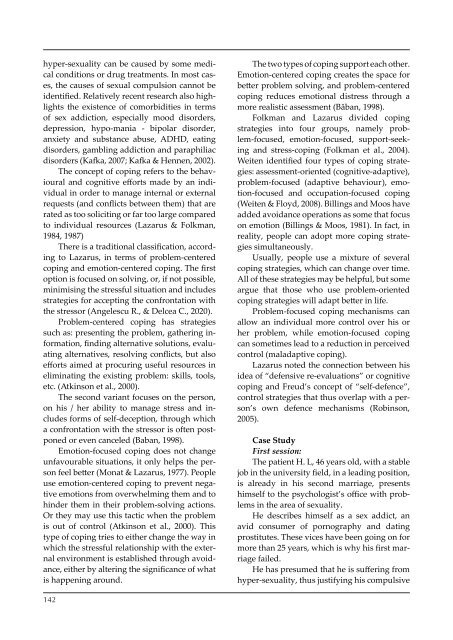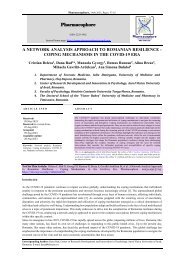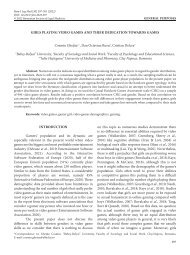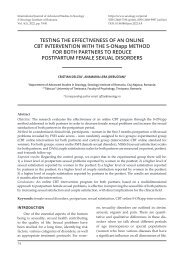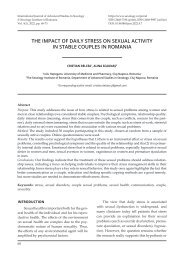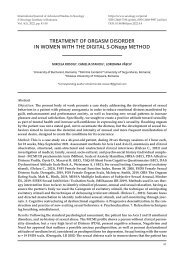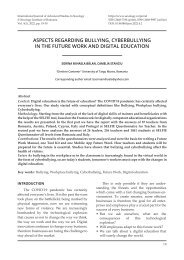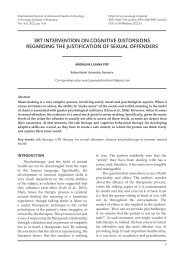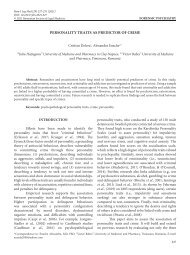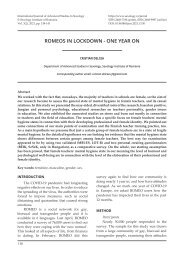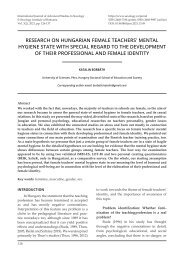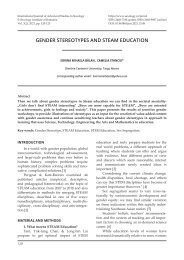Sex as a maladaptive coping mechanism in hypersexuality disorder
The confrontation with the controversial construct of sex addiction reveals not only the heterogeneity of the group of those affected, but also the multitude of aspects that must be taken into account when determining whether this is a singled out, independent disorder or not. Clinical practice experiences also highlight the diversity of relevant influencing factors to consider, as well as the importance of maladaptive coping mechanisms that sustain addiction. The case study presented in this paper was deliberately chosen because clinical cases have repeatedly shown that these two areas, the lack of privacy and the lack of access to their own feelings, play a decisive role in the development of addictions in patients, as well as in the maintenance of this addiction. Therefore, it requires increased attention in therapy.
The confrontation with the controversial construct of sex addiction reveals not only the heterogeneity of the group of those affected, but also the multitude of aspects that must be taken into account when determining whether this is a singled out, independent disorder or not. Clinical practice experiences also highlight the diversity of relevant influencing factors to consider, as well as the importance of maladaptive coping mechanisms that sustain addiction. The case study presented in this paper was deliberately chosen because clinical cases have repeatedly shown that these two areas, the lack of privacy and the lack of access to their own feelings, play a decisive role in the development of addictions in patients, as well as in the maintenance of this addiction. Therefore, it requires increased attention in therapy.
You also want an ePaper? Increase the reach of your titles
YUMPU automatically turns print PDFs into web optimized ePapers that Google loves.
hyper-sexuality can be caused by some medical<br />
conditions or drug treatments. In most c<strong>as</strong>es,<br />
the causes of sexual compulsion cannot be<br />
identified. Relatively recent research also highlights<br />
the existence of comorbidities <strong>in</strong> terms<br />
of sex addiction, especially mood <strong>disorder</strong>s,<br />
depression, hypo-mania - bipolar <strong>disorder</strong>,<br />
anxiety and substance abuse, ADHD, eat<strong>in</strong>g<br />
<strong>disorder</strong>s, gambl<strong>in</strong>g addiction and paraphiliac<br />
<strong>disorder</strong>s (Kafka, 2007; Kafka & Hennen, 2002).<br />
The concept of <strong>cop<strong>in</strong>g</strong> refers to the behavioural<br />
and cognitive efforts made by an <strong>in</strong>dividual<br />
<strong>in</strong> order to manage <strong>in</strong>ternal or external<br />
requests (and conflicts between them) that are<br />
rated <strong>as</strong> too solicit<strong>in</strong>g or far too large compared<br />
to <strong>in</strong>dividual resources (Lazarus & Folkman,<br />
1984, 1987)<br />
There is a traditional cl<strong>as</strong>sification, accord<strong>in</strong>g<br />
to Lazarus, <strong>in</strong> terms of problem-centered<br />
<strong>cop<strong>in</strong>g</strong> and emotion-centered <strong>cop<strong>in</strong>g</strong>. The first<br />
option is focused on solv<strong>in</strong>g, or, if not possible,<br />
m<strong>in</strong>imis<strong>in</strong>g the stressful situation and <strong>in</strong>cludes<br />
strategies for accept<strong>in</strong>g the confrontation with<br />
the stressor (Angelescu R., & Delcea C., 2020).<br />
Problem-centered <strong>cop<strong>in</strong>g</strong> h<strong>as</strong> strategies<br />
such <strong>as</strong>: present<strong>in</strong>g the problem, gather<strong>in</strong>g <strong>in</strong>formation,<br />
f<strong>in</strong>d<strong>in</strong>g alternative solutions, evaluat<strong>in</strong>g<br />
alternatives, resolv<strong>in</strong>g conflicts, but also<br />
efforts aimed at procur<strong>in</strong>g useful resources <strong>in</strong><br />
elim<strong>in</strong>at<strong>in</strong>g the exist<strong>in</strong>g problem: skills, tools,<br />
etc. (Atk<strong>in</strong>son et al., 2000).<br />
The second variant focuses on the person,<br />
on his / her ability to manage stress and <strong>in</strong>cludes<br />
forms of self-deception, through which<br />
a confrontation with the stressor is often postponed<br />
or even canceled (Baban, 1998).<br />
Emotion-focused <strong>cop<strong>in</strong>g</strong> does not change<br />
unfavourable situations, it only helps the person<br />
feel better (Monat & Lazarus, 1977). People<br />
use emotion-centered <strong>cop<strong>in</strong>g</strong> to prevent negative<br />
emotions from overwhelm<strong>in</strong>g them and to<br />
h<strong>in</strong>der them <strong>in</strong> their problem-solv<strong>in</strong>g actions.<br />
Or they may use this tactic when the problem<br />
is out of control (Atk<strong>in</strong>son et al., 2000). This<br />
type of <strong>cop<strong>in</strong>g</strong> tries to either change the way <strong>in</strong><br />
which the stressful relationship with the external<br />
environment is established through avoidance,<br />
either by alter<strong>in</strong>g the significance of what<br />
is happen<strong>in</strong>g around.<br />
The two types of <strong>cop<strong>in</strong>g</strong> support each other.<br />
Emotion-centered <strong>cop<strong>in</strong>g</strong> creates the space for<br />
better problem solv<strong>in</strong>g, and problem-centered<br />
<strong>cop<strong>in</strong>g</strong> reduces emotional distress through a<br />
more realistic <strong>as</strong>sessment (Băban, 1998).<br />
Folkman and Lazarus divided <strong>cop<strong>in</strong>g</strong><br />
strategies <strong>in</strong>to four groups, namely problem-focused,<br />
emotion-focused, support-seek<strong>in</strong>g<br />
and stress-<strong>cop<strong>in</strong>g</strong> (Folkman et al., 2004).<br />
Weiten identified four types of <strong>cop<strong>in</strong>g</strong> strategies:<br />
<strong>as</strong>sessment-oriented (cognitive-adaptive),<br />
problem-focused (adaptive behaviour), emotion-focused<br />
and occupation-focused <strong>cop<strong>in</strong>g</strong><br />
(Weiten & Floyd, 2008). Bill<strong>in</strong>gs and Moos have<br />
added avoidance operations <strong>as</strong> some that focus<br />
on emotion (Bill<strong>in</strong>gs & Moos, 1981). In fact, <strong>in</strong><br />
reality, people can adopt more <strong>cop<strong>in</strong>g</strong> strategies<br />
simultaneously.<br />
Usually, people use a mixture of several<br />
<strong>cop<strong>in</strong>g</strong> strategies, which can change over time.<br />
All of these strategies may be helpful, but some<br />
argue that those who use problem-oriented<br />
<strong>cop<strong>in</strong>g</strong> strategies will adapt better <strong>in</strong> life.<br />
Problem-focused <strong>cop<strong>in</strong>g</strong> <strong>mechanism</strong>s can<br />
allow an <strong>in</strong>dividual more control over his or<br />
her problem, while emotion-focused <strong>cop<strong>in</strong>g</strong><br />
can sometimes lead to a reduction <strong>in</strong> perceived<br />
control (<strong>maladaptive</strong> <strong>cop<strong>in</strong>g</strong>).<br />
Lazarus noted the connection between his<br />
idea of “defensive re-evaluations” or cognitive<br />
<strong>cop<strong>in</strong>g</strong> and Freud’s concept of “self-defence”,<br />
control strategies that thus overlap with a person’s<br />
own defence <strong>mechanism</strong>s (Rob<strong>in</strong>son,<br />
2005).<br />
C<strong>as</strong>e Study<br />
First session:<br />
The patient H. L, 46 years old, with a stable<br />
job <strong>in</strong> the university field, <strong>in</strong> a lead<strong>in</strong>g position,<br />
is already <strong>in</strong> his second marriage, presents<br />
himself to the psychologist’s office with problems<br />
<strong>in</strong> the area of sexuality.<br />
He describes himself <strong>as</strong> a sex addict, an<br />
avid consumer of pornography and dat<strong>in</strong>g<br />
prostitutes. These vices have been go<strong>in</strong>g on for<br />
more than 25 years, which is why his first marriage<br />
failed.<br />
He h<strong>as</strong> presumed that he is suffer<strong>in</strong>g from<br />
hyper-sexuality, thus justify<strong>in</strong>g his compulsive<br />
142


